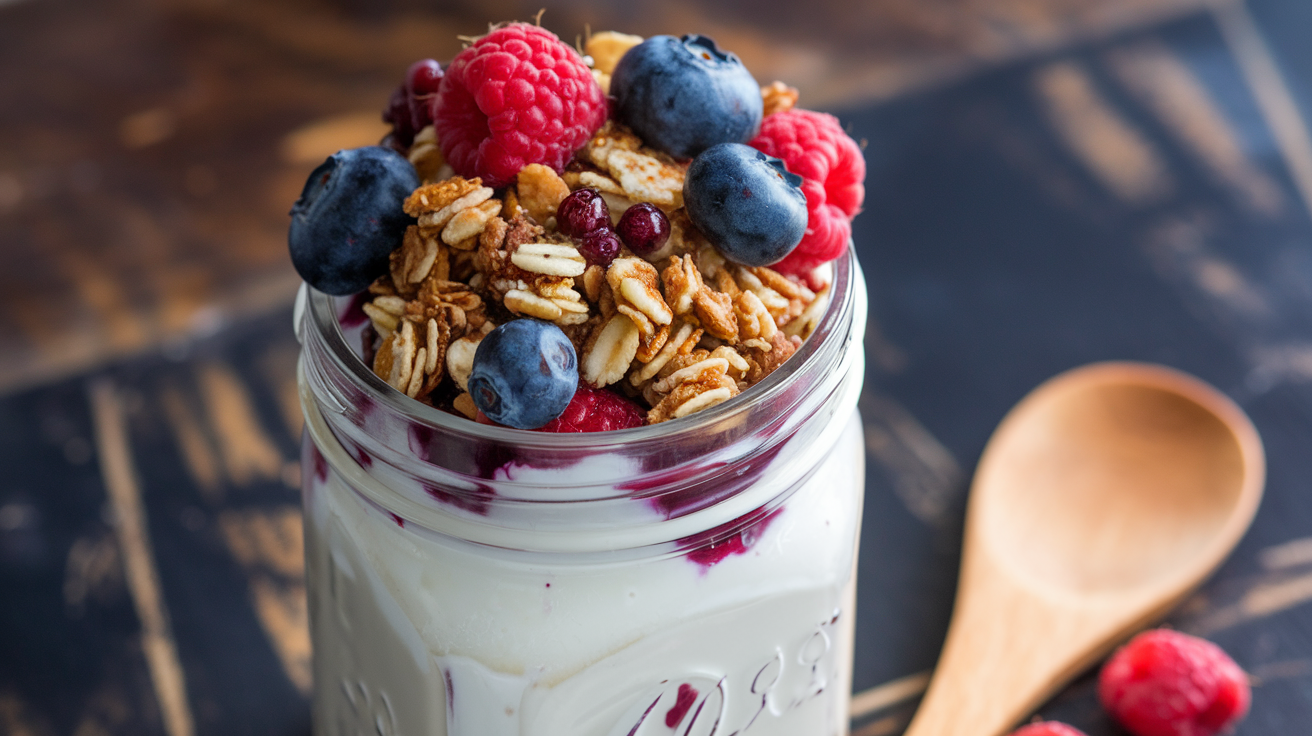Introduction: Why Make Homemade Yogurt?
Homemade yogurt is incredibly simple to make and far more flavorful and fresh than store-bought varieties. With just two ingredients—milk and a starter culture (plain yogurt)—you can create a creamy and delicious yogurt that’s free of additives and preservatives. Plus, making yogurt at home allows you to control the sweetness, thickness, and flavors to suit your preferences.
Yogurt is a versatile food that can be enjoyed on its own, added to smoothies, served with fresh fruit and granola, or used in savory dishes. Let’s dive into how to make it yourself.
Ingredients for Homemade Yogurt
You only need two ingredients to make yogurt, but their quality is key to a successful and tasty result.
Core Ingredients:
- 1 liter (4 cups) milk (whole, 2%, or skim; whole milk will make the creamiest yogurt)
- 2 tablespoons plain yogurt with live active cultures (for the starter; Greek or regular yogurt works)
Optional:
- Powdered milk (1-2 tablespoons to thicken the yogurt, if desired)
- Sweeteners or flavors (vanilla extract, honey, fruit purees)
How to Make Yogurt: Step-by-Step Guide
Making yogurt at home involves gently heating the milk, cooling it, and adding a yogurt culture before letting it ferment. Follow these easy steps for perfect homemade yogurt:
Step 1: Heat the Milk
- Pour the milk into a large saucepan or pot. If using powdered milk to thicken the yogurt, whisk it into the milk at this stage.
- Heat the milk over medium heat, stirring occasionally to prevent scorching. Heat until it reaches 85°C (185°F), just below boiling. This process helps change the protein structure of the milk, resulting in a thicker yogurt.
Step 2: Cool the Milk
- Remove the pot from the heat and let the milk cool to 45°C (113°F). You can speed up the cooling by placing the pot in a bowl of ice water and stirring gently.
- If you don’t have a thermometer, the milk should feel warm but not hot to the touch.
Step 3: Add the Starter Yogurt
- In a small bowl, mix 2 tablespoons of plain yogurt with a little of the cooled milk until smooth. Then, pour this mixture back into the pot of warm milk and stir gently to combine. This process introduces the live cultures into the milk.
Step 4: Incubate the Yogurt
- Transfer the mixture to a clean container (a glass jar or bowl with a lid works well). Cover the container with a lid, towel, or plastic wrap.
- Keep the yogurt warm to encourage fermentation. You can use one of the following methods to incubate your yogurt for 4-12 hours, depending on how tangy and thick you like it:
- Oven Method: Place the yogurt in a warm (but turned off) oven with the light on.
- Insulated Cooler: Place the yogurt container in a small cooler filled with warm water (around 50°C/122°F).
- Yogurt Maker or Instant Pot: Use the yogurt setting to maintain a consistent warm temperature.
- The longer you incubate, the tangier and thicker the yogurt will be.
Step 5: Check the Yogurt and Chill
- Check the yogurt after about 4 hours. It should be set and have a creamy texture. If you want a tangier flavor, let it ferment longer, up to 12 hours.
- Once it reaches your desired consistency and flavor, refrigerate the yogurt for at least 2 hours to chill and set fully before serving.
Tips for Perfect Homemade Yogurt
- Choose High-Quality Ingredients: Use good-quality milk and yogurt with live cultures for the best flavor and texture.
- Consistent Temperature: Keep the yogurt at a stable warm temperature during fermentation to encourage proper thickening.
- Save a Portion for Next Time: Use a few tablespoons of your homemade yogurt as a starter for your next batch. This way, you won’t need to buy store-bought yogurt again.
- Add Flavors After Chilling: If you want flavored yogurt, mix in sweeteners, vanilla, fruit purees, or spices after the yogurt has chilled.
Flavor Variations for Yogurt
Once your yogurt is made, you can flavor it in endless ways to suit your taste:
1. Vanilla Yogurt
- Stir in 1-2 teaspoons vanilla extract and a tablespoon of honey or maple syrup for a classic vanilla flavor.
2. Fruit Yogurt
- Blend your yogurt with fruit puree like berries, peaches, or mango for a fresh, fruity taste. Sweeten to taste with honey or sugar.
3. Greek Yogurt
- To make thick Greek-style yogurt, strain the yogurt through a cheesecloth or fine-mesh strainer for 1-2 hours to remove the whey.
4. Savory Yogurt
- For a savory version, mix in a pinch of salt, garlic powder, cucumber, and herbs like dill or mint to create a yogurt dip or sauce.
Serving Suggestions for Yogurt
Homemade yogurt is delicious on its own, but it also pairs well with many dishes:
- Breakfast Bowl: Top with fresh fruit, nuts, seeds, and a drizzle of honey for a nutritious breakfast.
- Smoothies: Use your yogurt as a base for smoothies, blending it with fruits, greens, and a touch of sweetener.
- Marinades and Dressings: Use yogurt as a base for marinades for meats or as a creamy dressing for salads.
- Desserts: Serve yogurt with fruit compote, granola, or over warm cobblers and crisps for a balanced dessert.
Conclusion: Enjoy Your Homemade Yogurt
Making yogurt at home is a rewarding and cost-effective way to enjoy a delicious, creamy, and versatile treat. Once you master the basic recipe, you can customize it with flavors and toppings to enjoy yogurt exactly how you like it.
Call to Action: Ready to make your own yogurt? Try this recipe and share your results using #HomemadeYogurtMaster! Don’t forget to subscribe for more delicious recipes and tips.
This guide provides you with everything you need to make creamy, delicious yogurt at home, along with tips for customization and serving ideas. Enjoy!

